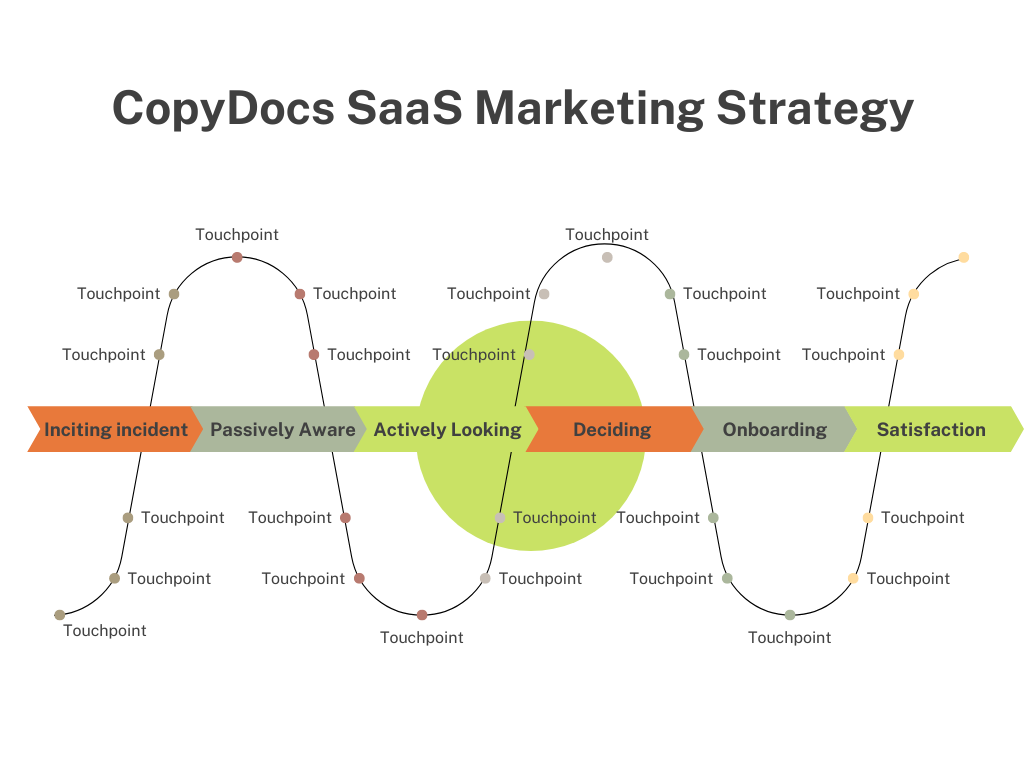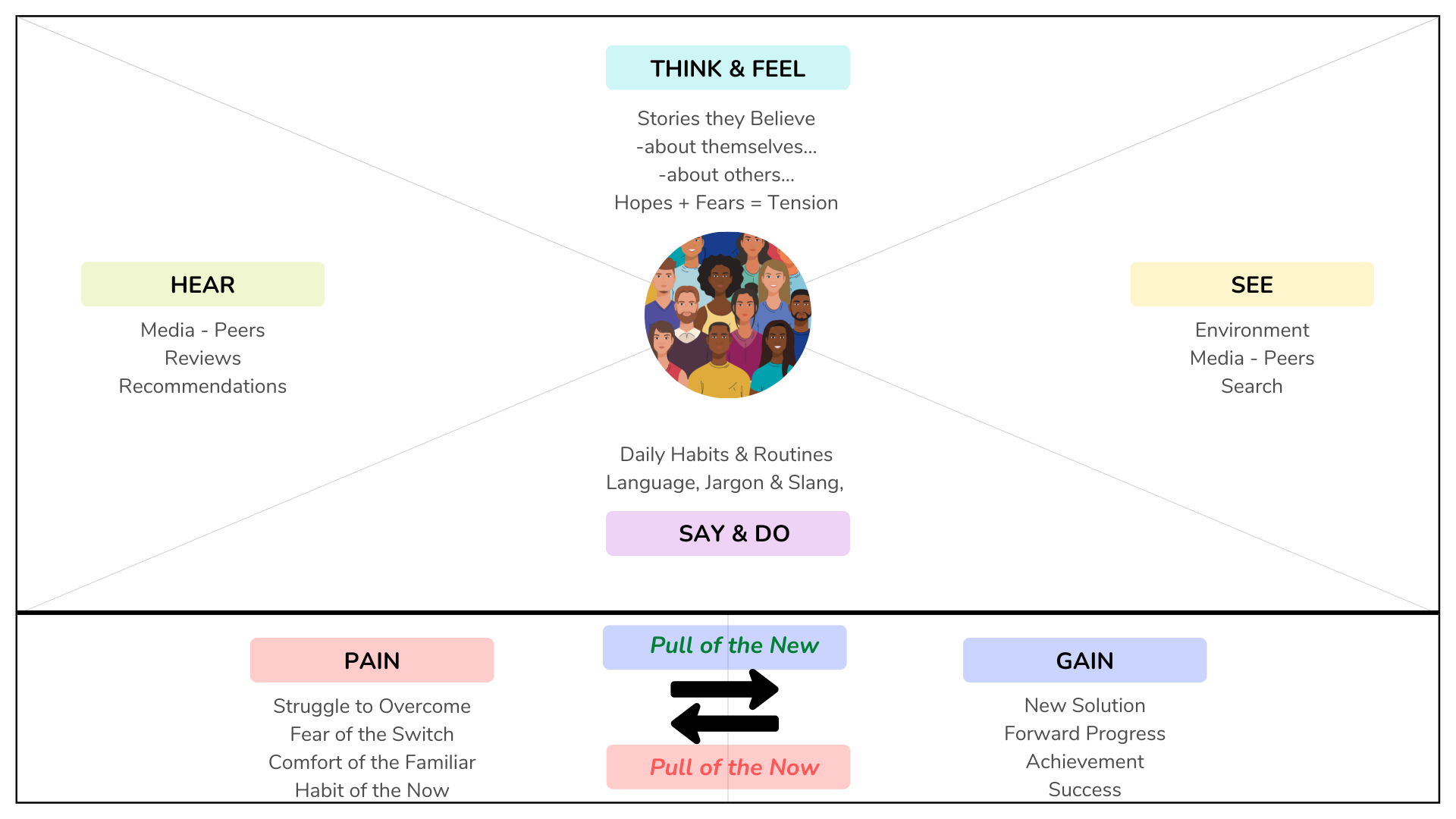SaaS Marketing
For SaaS Startups
We’re a SaaSy little marketing agency for B2B SaaS startups that want to get their first 10,000 customers.
We do that through laser-focused positioning, brand marketing roadmaps, solution-experience strategy, and growth marketing.
The result?
You hit the ground running with a custom-built demand-generation pipeline created with all the latest insights and strategies in B2B SaaS marketing.
What is SaaS marketing?
Successful SaaS marketing leans heavily on content marketing, digital marketing in all its forms, product demos, tutorials, direct sales efforts, and continual follow-up.
Successful marketers communicate to understand the customer's needs, build relationships, and educate.
Persuasion and sales have their place.
But Software as a Service (SaaS) is subscription-based, so we focus on the customer's needs first.

Service is the name of the game in SaaS.
SaaS marketing is about providing long-term value. SaaS marketing is about building relationships with prospects and customers so that they will buy from you repeatedly.
That's why it's essential to understand who your customers are, what they need and want, and how they behave.
With this understanding, you can create a SaaS marketing strategy that will engage prospective customers and lead them to the desired results.
Your marketing efforts should position your SaaS products as unique and specific solutions for individual and specific problems.
SaaS marketing introduces products in a (mostly) digital space through content marketing, direct marketing, and sales.
Content marketing can take many forms:
- Blog posts,
- Webinars,
- Infographics
- Long and short-form videos,
- eBooks, white papers, and special reports
The unique nature of SaaS products means that marketers often need to think more strategically than traditional marketing teams.
That's because prospective customers may need help finding SaaS products' solutions.
That means savvy SaaS marketers have to think more like direct response copywriters than traditional marketers. The most successful SaaS marketers work closely with the sales team to ensure the best product presentation for the best sales results.
To entice long-term subscribers, your SaaS marketing needs to stand out in the fast-growing SaaS market and attract your perfect customer.

What makes SaaS marketing unique?
SaaS marketing is unique because every SaaS product is unique.
SaaS products serve a particular group of people struggling with a specific problem.
And chances are, your target audience is not looking for your solution.
They may not even have a name for their struggle yet, which stacks the deck against you in several ways.
Why is SaaS marketing so challenging?
The SaaS market has become more competitive and dynamic in the last few years. As a result, the marketing funnel has more steps, and the options for lead generation have grown exponentially.
Chances are, prospective customers aren't actively searching for your solution, which can be problematic.
The good news is that by following some simple best practices, you can create a marketing strategy that ensures you show up when and where you're prospective customers are looking for the solution you provide.
You need a kickass Go-to-Market SaaS marketing strategy.
You need...
- Demos
- Sign-ups
- Subscriptions, and
- Upgrades
You need sales. Plain and simple.
We’ve created custom marketing solutions for SaaS companies, large and small.

- 10x demo bookings
- Seamless onboarding systems
- Done-for-you referral networks
- Case studies
- Viral social sharing
And now it's your turn.
How do I create a SaaS marketing strategy?
There are six steps to the SaaS buyer's journey, so your marketing strategy should match the buyer's journey.
Not many SaaS Marketing agencies follow this strategy, but we do. And so should you.
Let’s take a look at what you need to know.
Trust the CopyDocs SaaS marketing strategy.
Our marketing strategy follows the buyer's journey and is modeled after the Jobs To Be Done (JTBD) framework created by Bob Moesta and Greg Engle in their book Demand Side Sales.
Following the buyer's journey, we focus your marketing strategy on these 6 phases.

Phase One: The inciting incident
Something happens.
You're trying to do something, and you can't, or doing that thing is way harder than it used to be.
It could be anything.
But whatever it is, it's creating substantial friction in your life; enough conflict to say:
"I want something different -something better.
This is your 'struggling moment.'
What is your customer's Struggling Moment?What is your customer trying to do? Where are they struggling?
These struggling moments accumulate over time and eventually create enough space in the brain to entertain the idea that there must be something better.
The agitation has created space in your mind to consider a change.
Phase Two: Passive awareness
Once you've had enough struggling moments to realize you have a problem and that there must be something better, your brain is wired to start passively looking for possible solutions.
You start to see things that make you wonder if they might offer the relief you need.
You're not actively looking yet, but you're beginning to feel there's a better way. So your subconscious brain is on the hunt.

Phase Three: Actively looking
By now, you're struggling moment has grown.
You're having a hard time now and growing tired of the battle. Whatever you're struggling with has become a burden, affecting your quality of life.
Maybe your struggle impacts your
- work,
- free time,
- relationships,
- productivity,
- sense of accomplishment or other things you want to do.
You get fed up with the battle and hunt for a solution to make your life easier.
Phase Four: Deciding
The marketplace is flooded with products and services, and search engines make it easier to find what you're looking for, right?
Not always. Not anymore.
When it comes to software-as-a-service (SaaS), the options are endless. And it can be hard to find the exact solution that fits your needs.
The way businesses and consumers find everything these days—from products to services—has changed dramatically.
The lines between business and consumer have blurred too.
And traditional sales and marketing methods are no longer effective.

To reach and sell to businesses in the modern world, you need a marketing strategy tailored to your end-users, decision-makers, and gatekeepers.
How does your customer find you -and then decide to pick you?
- How are you better than the Old Way?
- How hard is it going to be to learn the New Way?
This is where your marketing strategy pays off.
During the decision phase of the buyer's journey, your prospect is overwhelmed with options.
They need help deciding; they want to do what's right for them, so they're looking for someone they know, like, and trust.
And they need help understanding how your SaaS works.
How do you make your offer stand out as
- familiar,
- friendly
- easy to use, and
- trustworthy?
The best marketing strategies use customer interviews, case studies, social listening, and in-depth research to learn everything there is to know about your prospect.
You need to know everything there is to know about your customer and their struggles. And you need to know the language they use to think and talk about their pains, aggravation, and hassles.
And that's the Winning Difference.
Phase Five: Onboarding
Just because your prospect signed up for your trial doesn't mean they're a customer -not yet!
Onboarding is the most critical part of the buyer's journey. And for that reason, onboarding is one of the essential elements in your marketing strategy.
The all-important onboarding process includes
- Consistent outreach,
- Best practice tutorials
- Short-form videos that help your customers get 'quick wins.'
- Helpful suggestions, feedback, and encouragement.
Your onboarding deserves its dedicated marketing strategy.
Your onboarding marketing strategy needs to make your trial users feel successful, so they become ongoing users and happy product ambassadors.

Phase Six: Satisfaction
Each time your customer uses your SaaS, their subconscious mind evaluates it, judges it, and decides if it's still doing the job they hired.
And depending on how many other SaaS products your customers considered on their buyer's journey and how many trials they signed up for along the way, chances are, your customers are still receiving marketing messages from your competitors.
That means the job of marketing your SaaS is never done.
So how do I market my SaaS product myself?
Breaking into a flooded SaaS market requires getting in front of the right people, in the right places, at the right time, and with the right offer.
But that's not as easy as it used to be.
Because here's the truth:
No one cares.

No one cares about your new SaaS, breakthrough technology, or how you can "streamline this and eliminate that!"
No one cares because every SaaS marketing team says the same things about your competitors.
Every SaaS product in the ever-growing, crowded marketplace can...
- Eliminate manual data entry
- Streamline workflows
- Increase accuracy
- Automate processes
- Save time
- Decreases expenses and,
- Increase profits
Your prospective customers expect all those benefits, so you need to be different.
What's your Winning Difference?
Your product's differentiation makes it unique from other options in its category.
That's your competitive advantage.
Your ability to differentiate your SaaS from other offers is crucial to SaaS Success.
Your winning differentiators can include
- Features
- Benefits
- Better Quality
- Exceptional Service.
Unique features and benefits can also be your product's differentiators.
How can I get people interested in my SaaS?
You need to tell a compelling story.
SaaS customers are people, just like you and me. And all people are driven by emotion.
We connect with our emotions, and with each other, through Stories.
What's your customer's story?
What journey are your customers on?
What are they trying to achieve, and where do they want to go?
Once you know their story, you can help your customers FEEL what it's like to be FREE of whatever holds them back.
Why is the customer journey important in SaaS marketing?
Everyone is on a journey.
Life is a journey, your childhood was a journey, your adulthood, every one of your relationships, and even your career is a journey.
Journeys are deeply embedded in our DNA, even if we don't realize it.
We seek out journeys in our lives and others. We enjoy watching journeys in movies and hearing them in our favorite songs.
Everyone enjoys a journey -especially when it takes them from their everyday, regular, boring, humdrum life and transports them to someplace magical and new.
That's a journey of transformation!
That's the Hero's Journey.
Everyone is on their own Hero's Journey – especially your SaaS customer.
SaaS marketers need to meet the customer where they're struggling and help them feel successful; help them feel how only our SaaS solution solves their most pressing problems.
Savvy SaaS Marketing
Savvy SaaS marketing requires empathy, generosity, just the right amount of tension...and relief.
Your customers will feel relief when you show them how their lives improve.
What a relief they'll feel when their story has a happy ending.

What is a Persona in SaaS marketing?
In SaaS marketing, a buyer persona refers to a semi-fictional representation of your ideal customer.
And it's total bullshit.
Personas don't buy Saas products; people do.
This is because people struggle to do something, be something or go somewhere.
"But wait!" you say.
"Aren't Personas important in marketing?"
"How will we know where to direct our marketing efforts? Where will we find our 'Ideal Customers'?"
Why personas don't matter in SaaS marketing
If you've done your homework and built a SaaS product that solves a problem or serves people in some capacity, you've got a great start.
You have to connect with the people you built your product for. And for that, you can follow this simple 5-step process.
- Know your customer.
- Consistently show up in your customers' lives.
- Consistently show them you care.
- Make life easier and more pleasant for the people you serve.
- ...rinse and repeat.

Know your customer (not their persona)
Your customers are people in a struggle.
- What is your customer struggling with?
- What's their pain?
- What are they trying to do? Where are they trying to go?
- What's the language they use when they talk about their struggles?
- What words do they say out loud or think inside their heads?
Marketing is a conversation, so you need to know the language, and you also need to know how you're customer feels.
Successful marketing is empathetic, generous, and seeks first to understand.
Consistently show up
The SaaS market is flooded with apps that serve a wide range of people and solve many problems.
You're just a tiny fish in an enormous ocean of options. But that's okay because you know who you're talking to and why.
Consistently show up for the people you serve and talk about what they care about. Then, help them solve more minor problems that lead them to trust in you and your ability to help them solve their struggling moments.
Let them get to know you, like you, and trust you as you get to learn more about them and what they need.
Don't compete -ConnectYou don't have to compete; you only have to connect with the people you can help, show them how you can help using the words they use themselves, and then consistently help them be successful through ongoing service and support.
Remember, no one cares about your Software.
People remember how you make them feel.
They remember your Service.
So, put your service on display.
Show you care
Service is the name of the game.
I mean, literally... right?
It's baked into the name of your product: Software as a Service.
B2B SaaS, B2C SaaS, it doesn't matter.
You're in the business of providing service.
And service must never stop.
Make life easier
Make it easy for your customers to be successful,
Coach them, give them quick wins, and help them succeed every step of the way–especially when they visit your website and engage with your SaaS product.
The proper definition of SaaS
SaaS products automate manual processes.
Your SaaS doesn't do anything new; it replaces the manual entry and workarounds your customers are already using.
That often makes it hard to describe your value proposition.
Potential customers will often think that eliminating manual tasks means that your software will replace their employees.
But in reality, the software enables people to focus on more value-adding work, which is more fulfilling and profitable.
SaaS makes a case for process automation.
Most research finds that automation improves the customer experience, reduces risk, enhances visibility, and produces faster reporting.
17% of respondents in one study reported that eliminating manual, repetitive tasks enabled them to move team members into more strategic roles within the organization.
And promotions always mean a significant improvement in morale.
What is a SaaS go-to-market strategy?
A go-to-market strategy is a strategic plan for introducing a new product or service to the market. SaaS go-to-market systems help companies effectively position, launch, and market their SaaS products.
Several factors need to be considered when crafting a SaaS go-to-market strategy, including
- Target market,
- Positioning,
- Messaging,
- Pricing, and
- Distribution channels.
SaaS marketing is a complicated process that requires many different tactics to succeed.
To attract customers, you need a marketing team skilled and experienced at creating well-defined SaaS go-to-market strategies.
The team needs to put in the time and research so they understand what you're trying to accomplish and how it can best reach your target audience.
One way to garner more customers is by creating content that educates potential customers and gets them interested in what you have to offer.
This can take the form of blogs, videos, and webinars, among other things.
What is a SaaS lead generation strategy?
A SaaS lead generation strategy is an overall plan that helps you to grow your business. It includes the tactics you'll use to generate, nurture, and eventually convert leads into customers, subscribers, and ongoing sales.
When deciding on a lead generation strategy, it's essential to consider the goals of your business and where your target audience spends their time online.
What is SaaS marketing automation?
Marketing automation is a way to automate specific tasks within your marketing efforts so you can focus on other areas of the business.
For example, if you want all your leads to fill out a lead form, you could set up an automation system so that if someone submits the form, the leads are automatically added to the correct folder in your email marketing program.
This allows you to focus on other tasks rather than manually adding people's information into different folders.
What is a SaaS lead nurturing strategy?
A SaaS lead nurturing strategy is similar to a sales funnel in that it starts with getting leads and then works towards converting those leads into sales.
However, while a sales funnel focuses on getting people from point A (awareness) to point B (purchase), a lead nurturing strategy focuses on working with leads through several stages until they are ready to purchase.
Lead nurturing strategies can include sending emails about new products or services, inviting people for webinars, or even sending them information about competitors' products or services so they can see how yours stack up.
How do I get more sales from my website?
Content marketing is a fantastic marketing strategy for creating more sales opportunities for your website.
By consistently creating and distributing valuable, relevant, and informative content, you can attract, nurture, and retain a clearly-defined audience— and, ultimately, drive more of your audience toward purchasing decisions.
What is B2B SaaS marketing?
B2B SaaS marketing is the strategy, tactics, and actions that promote a software-as-a-service product to businesses. It involves creating product awareness, generating interest among potential customers, and driving adoption by convincing companies to use the software.
B2B SaaS marketing is different from other types of marketing because the product is marketed and sold to businesses rather than consumers. Therefore, the target audience is diverse, and the marketing strategies must be tailored.
B2B SaaS marketing requires a deep understanding of the needs of businesses and how the software can address those needs. It also requires a good deal of the competitive landscape and how to position the product against competitors.
What is B2B SaaS content marketing?
B2B SaaS content marketing is creating and distributing valuable, relevant, helpful, and consistent content to attract and retain a clearly defined audience — and, ultimately, to drive profitable customer action.
Content marketing for B2B SaaS companies is not about selling. It's about creating and sharing content that educates, informs, entertains, or engages your target audience.
B2B SaaS content marketing aims to educate and inform potential customers about the benefits of using SaaS products.
B2B SaaS content marketing can take many forms, including blog posts, e-books, webinars, and infographics.
Why is content marketing important in SaaS?
As the SaaS industry becomes increasingly competitive, content marketing plays an increasingly important role in differentiating one company from another. Not only does high-quality content attract new leads, but it also helps to convert those leads into paying customers and retain them as loyal fans.
Content marketing provides value at every stage of the buyer's journey, from initial Awareness, Active Search through Decision, Onboarding, and Ongoing use.
If you're a SaaS company, you need to be doing content marketing. Here's why:
- People don't just want to buy things anymore - they want to buy into a story. So by creating compelling content, you can make a narrative around your brand that will attract customers.
- Content marketing is an effective way to build thought leadership and drive awareness for your company.
- SaaS companies need to stand out from the competition to succeed in the modern business world. Content marketing is one way to make your company's voice heard.
- Creating valuable, relevant content can attract new customers and nurture relationships with existing ones.
- Content marketing can help you build Trust and credibility with your audience, which is essential for any SaaS company.
How do you market a B2B SaaS without content?
To market a B2B SaaS without content, businesses need to focus on creating a solid relationship with their target audience.
- Build strong relationships
- Lean on your referral network
- Hire a well-connected direct sales team
- Make tons of cold calls
- Go door-to-door....literally
- Create personal connections with their target audience
- Take advantage of social media -especially LinkedIn
- Host webinars
- Create a sales funnel that will effectively guide potential customers through purchasing.
And finally, businesses need to offer something unique that will set them apart from their competitors.
So how do you market your B2B SaaS without content?
The short answer? You don't.
If you're a B2B SaaS company and you don't have a content marketing strategy, you're not reaching your full potential.
Content is essential for building trust and credibility with potential customers.
It's impossible to differentiate yourself from the competition without a strategic content marketing effort.
Content marketing is a critical component of the marketing mix for SaaS companies– but it's not always easy.
The basic idea is to create and distribute valuable content that builds trust and authority in your industry and ultimately drives more leads and sales.
But, these days, it's not as simple as it used to be.
With so much content being created daily, you must stand out from the crowd to get your message across.
And with the increasing sophistication of content marketing tools and platforms, you also need to ensure you're using the right tools for your business.
Otherwise, you could waste precious time, money, and energy– and still not get the desired results.
You should consider three things before starting your content marketing journey.
- What are your goals?
Before you start creating content, it's essential to know what your goals are. For example, are you looking for more leads? Sales? Brand awareness? Whatever your goals, make sure they align with your business objectives. For example, if you want more leads but don't have a sales team, focus on brand awareness and look for automation that leads prospective clients through a sales funnel. The important thing here is to define your goals clearly so that you can tailor your content strategy accordingly.
2) How do your competitors use content?
While there are many ways to use content marketing, one thing is clear: other SaaS companies are using it.
Therefore, if your competitors are doing it, there's a good chance you should too! And if they're not doing it yet, you can stand out from the crowd. To figure out how other SaaS companies use content marketing, start by looking at what they publish and how they promote it.
What types of articles do they publish? How often do they post them? What channels do they use to promote them (e. g., email campaigns)?
Once you understand their publishing strategy and promotion tactics, think about whether or not there is an opportunity for you to do something different or better.
3) What kind of content will resonate with your target audience?
Just because other companies publish certain types of content doesn't mean that this type of content will resonate with your target audience.
You need to be different in order to compete.
For example, you can create videos, blog posts, e-books, white papers, infographics, lead magnets, and more.
While it's easy to publish a blog post and call it content marketing, the reality is that not all blog posts are created equal.
You're wasting time if your target audience isn't reading your content or interacting with your brand.